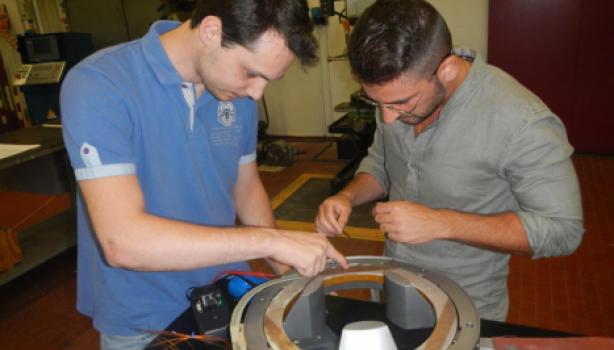In December 2018, the Future Circular Collider (FCC) collaboration submitted its Conceptual Design Report (CDR) for publication. The four-volume document signed documents different options for a large circular collider for the post-LHC era. The FCC CDR has more than 1300 contributors coming from 150 institutes from all over the world including universities, research centres and industrial partners who actively participated in the design effort and the R&D of new technologies to prepare for the sustainable deployment and efficient operation of a possible future circular collider.
The four volumes highlight the broad physics opportunities offered by machines that offer more energy, more intensity and more precision in exploring the fundamental nature of matter and describes the technical challenges along with the cost estimates and a concrete schedule for realisation.
The FCC collaboration has also submitted four volumes discussing the different options of a lepton collider, a hadron collider and the so-called integrated programme of these two options that can run from 2038 until the end of the 21st century. These documents will inform the next update of the European Strategy for Particle Physics and help the global particle physics community to outline the future of the field beyond the horizon of the LHC. The high statistics of the FCC- ee offers the opportunity for far- improved precision of electroweak and Higgs boson measurements. Other hints of new physics could arise from the observation of flavour- changing neutral currents or lepton- flavour-violating decays, from the precise measurements of the Z and Higgs bosons to their possible decays to invisible particles.
The FCC study was launched in 2014, as a response to the European Strategy meeting for particle physics, to prepare a global vision for the post-LHC era. Growing experimental evidence tells us rather clearly that there is more in the Universe than just the particles and the interactions that are described by the Standard Model. The compelling questions in modern physics call for a rigorous and diverse scientific program, with energy and intensity frontier accelerators being a fundamental component of it. Given the complexity and the different challenges of realising and operating these machines it is timely to launch now a feasibility study that helps to understand their exploratory potential as well as suggest strategic R&D to further increase the efficiency of these machines.
“The FCC’s ultimate goal is to provide a 100-km superconducting proton accelerator ring, with an energy of up to 100 TeV, meaning an order of magnitude more powerful than the LHC”, said CERN Director for Accelerators and Technology, Frédérick Bordry. “The FCC timeline foresees starting with an electron-positron machine, just as LEP preceded the LHC. This would enable a rich programme to benefit the particle physics community throughout the twenty-first century.”
The FCC study successfully launched new collaborations, to optimise the available resources, exploit the opportunities for training the new generation and strengthening industries that are an integral part of the ongoing R&D. The effort was supported by the EU H2020 programme through the EuroCirCol infrastructure design study. Moreover, the EASITrain Marie Curie training network (ITN) covers three key technologies for FCC, namely superconducting wires, superconducting thin films and cryogenic refrigeration, and provides a fertile environment where young researchers and experts from industry and research centres can develop innovative solutions that will allow large-scale applications of this alluring technology.
A 90 to 365 GeV electron-positron machine with high luminosity could be a first step. Such a collider would be a very powerful “Higgs factory”, making it possible to detect new, rare processes and measure the known particles with precisions never achieved before. These precise measurements would provide great sensitivity to possible tiny deviations from the Standard Model expectations, which would be a sign of new physics.
The lessons from the FCC- ee would be valuable for the next step: a future high- energy collider (FCC-hh). Using new-generation high-field superconducting magnets, the FCChh would offer a wide range of new physics opportunities. Reaching energies of 100 TeV and beyond would allow precise studies of how the recently discovered Higgs particle interacts with another Higgs particle and shed light to the fundamental nature of this particle. and thorough exploration of the role of the electroweak symmetry breaking in the history of our universe. It would also allow us to access higher energy scales, exploring the role of the electroweak symmetry breaking in the history of our Universe and looking for new massive particles and new phenomena. In addition, it would also collide heavy ions, sustaining a rich heavy-ion physics programme to study the state of matter in the early universe. Finally, the proposed research infrastructure further profits from an electron-proton collision point adding to the versatility of the proposed research programme.
A staged integrated programme is proposed, in which one of the colliders explored by the FCC study, the FCC-ee, could be operational by 2039, just after the end of the HL-LHC programme, which would be followed by an FCC-hh physics programme starting in 2050–2060. The options explored by the FCC study might sound reminiscent of the history of the LEP and LHC colliders housed in the same 27 km built in the 1980s. Together, these two machines, along with results from the Tevatron collider in the United States, verified and completed the SM of particle physics, contributing to it growing into the successful theory it is today.
The complex instruments required for particle physics inspire new concepts, innovation and groundbreaking technologies, which benefit other research disciplines and eventually find their way into many applications that have a significant impact on the knowledge economy and society. A future circular collider would offer extraordinary opportunities for industry, helping to push the limits of technology further. It would also provide exceptional training for a new generation of researchers and engineers.
The four volumes of the FCC CDR can be downloaded here: https://fcc-cdr.web.cern.ch/


